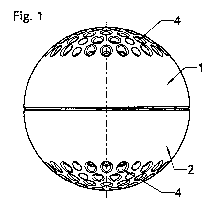Some of the information on this Web page has been provided by external sources. The Government of Canada is not responsible for the accuracy, reliability or currency of the information supplied by external sources. Users wishing to rely upon this information should consult directly with the source of the information. Content provided by external sources is not subject to official languages, privacy and accessibility requirements.
Any discrepancies in the text and image of the Claims and Abstract are due to differing posting times. Text of the Claims and Abstract are posted:
| (12) Patent Application: | (11) CA 2680068 |
|---|---|
| (54) English Title: | AN APPARATUS FOR THE BIOCIDAL TREATMENT OF LAUNDRY |
| (54) French Title: | DISPOSITIF DE TRAITEMENT BIOCIDE DE LINGE |
| Status: | Deemed Abandoned and Beyond the Period of Reinstatement - Pending Response to Notice of Disregarded Communication |
| (51) International Patent Classification (IPC): |
|
|---|---|
| (72) Inventors : |
|
| (73) Owners : |
|
| (71) Applicants : |
|
| (74) Agent: | AVENTUM IP LAW LLP |
| (74) Associate agent: | |
| (45) Issued: | |
| (86) PCT Filing Date: | 2008-03-06 |
| (87) Open to Public Inspection: | 2008-09-18 |
| Examination requested: | 2010-02-09 |
| Availability of licence: | N/A |
| Dedicated to the Public: | N/A |
| (25) Language of filing: | English |
| Patent Cooperation Treaty (PCT): | Yes |
|---|---|
| (86) PCT Filing Number: | PCT/EP2008/001811 |
| (87) International Publication Number: | WO 2008110300 |
| (85) National Entry: | 2009-09-04 |
| (30) Application Priority Data: | ||||||
|---|---|---|---|---|---|---|
|
The invention relates to a device for the treatment of laundry using biocides in a washing machine, comprising a hollow body (1, 2), in which a biocide substance is enclosed, and the cup of which has openings for the through-flow of the detergent and rinsing agent liquors. The biocide substance is selected such that it is at least substantially harmless to the human metabolism and effective in the laundered products for a certain time period beyond the washing process.
La présente invention concerne un dispositif de traitement biocide de linge dans un lave-linge, lequel dispositif est composé d'un corps creux (1, 2) qui renferme une substance biocide et dont la coque présente des ouvertures permettant le passage de l'eau de lavage et de l'eau de rinçage. La substance biocide est choisie de manière à être au moins dans la mesure du possible non toxique pour le métabolisme humain et pour être efficace dans le linge lavé pendant un certain temps au-delà du processus de lavage.
Note: Claims are shown in the official language in which they were submitted.
Note: Descriptions are shown in the official language in which they were submitted.

2024-08-01:As part of the Next Generation Patents (NGP) transition, the Canadian Patents Database (CPD) now contains a more detailed Event History, which replicates the Event Log of our new back-office solution.
Please note that "Inactive:" events refers to events no longer in use in our new back-office solution.
For a clearer understanding of the status of the application/patent presented on this page, the site Disclaimer , as well as the definitions for Patent , Event History , Maintenance Fee and Payment History should be consulted.
| Description | Date |
|---|---|
| Appointment of Agent Requirements Determined Compliant | 2022-01-27 |
| Revocation of Agent Requirements Determined Compliant | 2022-01-27 |
| Appointment of Agent Requirements Determined Compliant | 2018-05-18 |
| Revocation of Agent Requirements Determined Compliant | 2018-05-18 |
| Application Not Reinstated by Deadline | 2012-03-06 |
| Time Limit for Reversal Expired | 2012-03-06 |
| Deemed Abandoned - Failure to Respond to Maintenance Fee Notice | 2011-03-07 |
| Letter Sent | 2010-02-23 |
| All Requirements for Examination Determined Compliant | 2010-02-09 |
| Request for Examination Received | 2010-02-09 |
| Request for Examination Requirements Determined Compliant | 2010-02-09 |
| Amendment Received - Voluntary Amendment | 2010-01-05 |
| Inactive: Cover page published | 2009-11-19 |
| Inactive: Notice - National entry - No RFE | 2009-10-28 |
| Application Received - PCT | 2009-10-26 |
| Inactive: First IPC assigned | 2009-10-26 |
| National Entry Requirements Determined Compliant | 2009-09-04 |
| Small Entity Declaration Determined Compliant | 2009-09-04 |
| Application Published (Open to Public Inspection) | 2008-09-18 |
| Abandonment Date | Reason | Reinstatement Date |
|---|---|---|
| 2011-03-07 |
The last payment was received on 2009-12-15
Note : If the full payment has not been received on or before the date indicated, a further fee may be required which may be one of the following
Please refer to the CIPO Patent Fees web page to see all current fee amounts.
| Fee Type | Anniversary Year | Due Date | Paid Date |
|---|---|---|---|
| Basic national fee - small | 2009-09-04 | ||
| MF (application, 2nd anniv.) - small | 02 | 2010-03-08 | 2009-12-15 |
| Request for examination - small | 2010-02-09 |
Note: Records showing the ownership history in alphabetical order.
| Current Owners on Record |
|---|
| SMART FIBER AG. |
| Past Owners on Record |
|---|
| MICHAEL KOHNE |